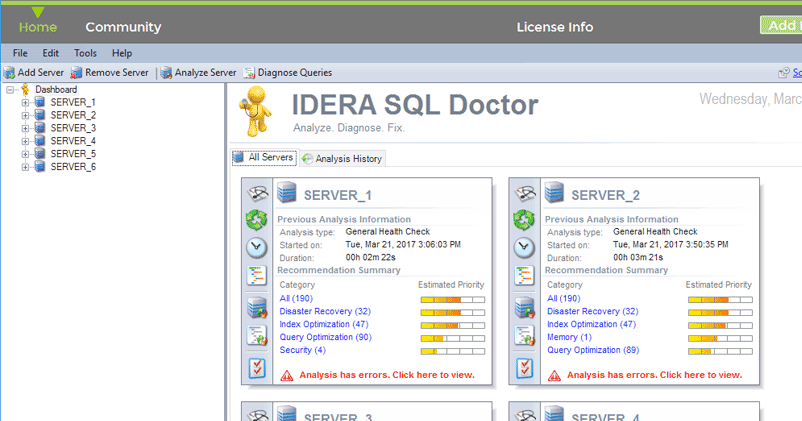
Quickly see the overall health of all registered servers, based on the last analysis run. From this tab, access quick links to the shared tasks for a server such as updating SQL Doctor settings, reviewing wait stats, and analyzing a query. Collect SQL Server performance information, analyze it, and determine the resolution in minutes rather than hours.
View recommendations
View a list of performance recommendations based on a full analysis based on selected criteria. The performance gain from making the suggested change, how relevant it is for the specified parameters when configuring the analysis, and the confidence SQL Doctor has in the recommendation determines the priority of the recommendation. Narrow the recommendations by targeted applications, selected performance categories, databases on the server, and more.
View server overview
Quickly see the overall health of each registered server, as of the last refresh. See a server health checklist that highlights where performance issues may be happening in real time. Review real-time, key performance metrics for each major area of the server. Display quick findings based on the values of the critical metrics to start troubleshooting performance problems immediately.
View SQL script
View the SQL text for a selected recommendation. Copy the SQL text to the clipboard to see it in a text editor or SQL Server Management Studio.
View analysis history
Access the results of every analysis stored by SQL Doctor for the registered SQL Server instances. Summaries include the name of the analyzed server, start time, total time duration, type of analysis performed, total number of recommendations, and highest priority recommendation. For each historical analysis, view recommendations, and delete and schedule an analysis.
Run real-time, as-needed, and scheduled health checkups
Schedule a regular analysis for an instance to track the health of SQL Server environments. Schedule daily or weekly check-ups to keep SQL Servers performing in top shape.
Select analysis categories
Choose any combination of categories: blocking processes, database configuration, deadlocks, disk, disaster recovery, index optimization, long-running jobs, memory, network, open transactions, and more.
Limit the analysis to specified databases and applications
Choose which database or application workload to include in the analysis. Block recommendations per instance to reduce analysis noise for undesirable changes. Block databases from being included in analyses.
View enterprise and server summaries
Based on the last analysis run, quickly see the overall health of all registered servers. Drill down to a selected instance, analysis, server, and recommendation.
Access analysis history and view trends
Access the results of every analysis stored for registered instances. View summaries and drill down to details.
View session data
Quickly view all sessions that are currently active with detailed performance metrics collected from Dynamic Management Views (DMV).
Pinpoint blocking and deadlocking sessions
Determine which sessions are blocking or are involved in a deadlock.
Find long running jobs
Identify jobs and transactions that may be running longer than usual.
Check security settings
Uncover many of the most common holes in security settings.
Verify disaster recovery
Identify database integrity issues and recovery methods that may leave the database in a potentially unrecoverable state.
Collect extended and SQL Trace events
Collect data using extended events and SQL Trace events. Automatically use the best method available depending on the SQL Server version, or decide to use SQL Trace events always.
Evaluate server and instance configuration
Examine configuration settings of SQL Server and the Windows operating system.
Find processor bottlenecks
Identify configuration settings that cause processor bottlenecks.
Check network
Diagnose issues with networking hardware and bandwidth.
Analyze application queries
Evaluate the most troublesome queries and gain immediate suggestions to improve their performance.
Display statistical details about query plans For SQL Server, Azure SQL Database, and Amazon RDS SQL Server and deliver recommendations to improve their performance.
Analyze custom queries by parsing the T-SQL script without actually executing the query to receive recommendations.
Check indexes
Diagnose databases indexes to determine possible performance optimizations.
Analyze wait stats
Analyze the most popular wait statistics that cause query delays for SQL Server, Azure SQL Database and Amazon RDS SQL Server.
View prioritized list of recommendations
Display the highest performance improvement options first according to a patented ranking system.
Cre ate Executable SQL scripts
Generate the executable SQL script to enact the recommended change. Also, generate reverse scripts for quickly undoing any of the previously run SQL scripts.
Export Recommendations
Export performance recommendations to disk for convenient distribution.
Access Cloud-specific Recommendations
Access enhanced and new expert recommendations that are unique to the managed cloud databases Azure SQL Database and Amazon RDS SQL Server.
Install on cloud virtual machines
Run SQL Doctor on cloud virtual machines with Windows – such as Microsoft Azure Virtual Machines (VMs) and Amazon Elastic Compute Cloud (EC2).
Access mapped cloud drives
SQL Doctor can access cloud storage that is mapped as network drives or removable drives on Microsoft Windows. For example, map to Azure Blob Storage and Amazon Simple Storage Service (S3).
Tune SQL Server on cloud virtual machines
Tune instances of SQL Server running on cloud virtual machines – such as Microsoft Azure VMs and Amazon EC2.
Tune SQL Server cloud databases
Tune the SQL Server cloud databases Azure SQL Database and Amazon RDS for SQL Server.
View cloud-specific recommendations
Access enhanced and new expert recommendations that are unique to the managed SQL Server cloud databases Azure SQL Database and Amazon RDS for SQL Server.
Monitor hybrid environments with a single tool
Avoid learning new tools by using the same tuning tool for SQL Server on-premises on physical and virtual machines, in the cloud on virtual machines, and the cloud as managed databases.
- Checkups
-
Run real-time, as-needed, and scheduled health checkups
Schedule a regular analysis for an instance to track the health of SQL Server environments. Schedule daily or weekly check-ups to keep SQL Servers performing in top shape.
Select analysis categories
Choose any combination of categories: blocking processes, database configuration, deadlocks, disk, disaster recovery, index optimization, long-running jobs, memory, network, open transactions, and more.
Limit the analysis to specified databases and applications
Choose which database or application workload to include in the analysis. Block recommendations per instance to reduce analysis noise for undesirable changes. Block databases from being included in analyses.
View enterprise and server summaries
Based on the last analysis run, quickly see the overall health of all registered servers. Drill down to a selected instance, analysis, server, and recommendation.
Access analysis history and view trends
Access the results of every analysis stored for registered instances. View summaries and drill down to details.
- Diagnosis
-
View session data
Quickly view all sessions that are currently active with detailed performance metrics collected from Dynamic Management Views (DMV).
Pinpoint blocking and deadlocking sessions
Determine which sessions are blocking or are involved in a deadlock.
Find long running jobs
Identify jobs and transactions that may be running longer than usual.Check security settings
Uncover many of the most common holes in security settings.
Verify disaster recovery
Identify database integrity issues and recovery methods that may leave the database in a potentially unrecoverable state.
Collect extended and SQL Trace events
Collect data using extended events and SQL Trace events. Automatically use the best method available depending on the SQL Server version, or decide to use SQL Trace events always.
Evaluate server and instance configuration
Examine configuration settings of SQL Server and the Windows operating system.
Find processor bottlenecks
Identify configuration settings that cause processor bottlenecks.
Check network
Diagnose issues with networking hardware and bandwidth.
- SQL Query Tuning
-
Analyze application queries
Evaluate the most troublesome queries and gain immediate suggestions to improve their performance.
Display statistical details about query plans For SQL Server, Azure SQL Database, and Amazon RDS SQL Server and deliver recommendations to improve their performance.
Analyze custom queries by parsing the T-SQL script without actually executing the query to receive recommendations.
Check indexes
Diagnose databases indexes to determine possible performance optimizations.
Analyze wait stats
Analyze the most popular wait statistics that cause query delays for SQL Server, Azure SQL Database and Amazon RDS SQL Server.
- Problem Resolution
-
View prioritized list of recommendations
Display the highest performance improvement options first according to a patented ranking system.
Cre ate Executable SQL scripts
Generate the executable SQL script to enact the recommended change. Also, generate reverse scripts for quickly undoing any of the previously run SQL scripts.
Export Recommendations
Export performance recommendations to disk for convenient distribution.
Access Cloud-specific Recommendations
Access enhanced and new expert recommendations that are unique to the managed cloud databases Azure SQL Database and Amazon RDS SQL Server.
- Cloud
-
Install on cloud virtual machines
Run SQL Doctor on cloud virtual machines with Windows – such as Microsoft Azure Virtual Machines (VMs) and Amazon Elastic Compute Cloud (EC2).
Access mapped cloud drives
SQL Doctor can access cloud storage that is mapped as network drives or removable drives on Microsoft Windows. For example, map to Azure Blob Storage and Amazon Simple Storage Service (S3).
Tune SQL Server on cloud virtual machines
Tune instances of SQL Server running on cloud virtual machines – such as Microsoft Azure VMs and Amazon EC2.
Tune SQL Server cloud databases
Tune the SQL Server cloud databases Azure SQL Database and Amazon RDS for SQL Server.
View cloud-specific recommendations
Access enhanced and new expert recommendations that are unique to the managed SQL Server cloud databases Azure SQL Database and Amazon RDS for SQL Server.
Monitor hybrid environments with a single tool
Avoid learning new tools by using the same tuning tool for SQL Server on-premises on physical and virtual machines, in the cloud on virtual machines, and the cloud as managed databases.
Let’s get started.
Start your 14-day trial, no credit card required (but all fields are)





